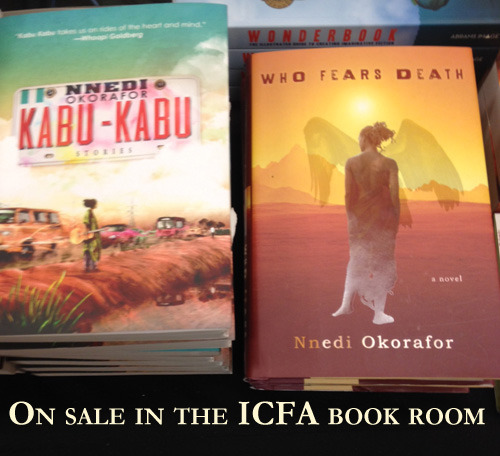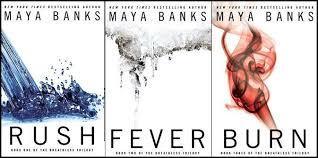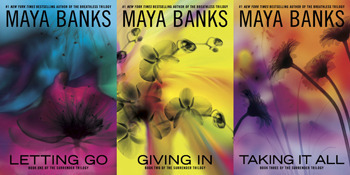Cecilia Tan's Blog, page 28
March 20, 2014
Nnedi Okorafor’s ICFA Guest of Honor speech
The wonderful guest of honor luncheon address was given at ICFA today by Nnedi Okorafor, the author of many books and the winner of many awards, including the World Fantasy Award, Carl Brandon Parallax Award, and others. She is Nigerian-American, is a graduated of the Clarion sf workshop, and got her PhD at U. of Illinois over 10 years ago–I missed the exact year in the introductions. The woman introducing Nnedi described her work as books which “blends magical fantasy and political realism.”
If you read my post earlier today about the Night Vale and creepypasta panel I went to, you know that the takeaway from it for me as a writer was the idea that the concept of the protagonist (or scholar ) as a passive observer who is untouched by events in a book (or by the subject being studied) is a highly colonial one, whereas both feminist and postcolonial modes of thought accept the necessity of both the subject and the environment being changed by their interaction.
Not too surprisingly (because synchronicity), this idea came up also in Nnedi Okorafor’s speech. What follows here is a partial transcript of her speech. I don’t actually type fast enough to get 100% — I can capture about 75%, and then I have edited this down to about 50% for clarity and relevance. Also, hey, if you want ALL the good stuff, you should be coming to the conference.
Everywhere you see words in square brackets [like this] it’s where I paraphrased something she said because I couldn’t type fast enough.
Excerpt from Nnedi Okorafor’s ICFA guest of honor speech:
I was in jail the night I became the first African American to win the World Fantasy Award.
I teach at Chicago State University, located on the South Side, the distressed area. You don’t have to walk far to get to the problematic sections. The crime that Chicago is known for is found very near the university. The university is a beacon of light in a dark area. Maybe I shouldn’t have used that problematic metaphor: “dark” and “light.” Many of my students are the first in their families to go to college. For me, growing up in a privileged upper-middle-class area, it’s [been eye-opening.]
One of my favorite students was Jermaine Reid, who grew up in one of the infamous projects. I remember when the Robert Taylor Homes were still standing. When I would drive past them I would roll up my windows and speed. The way Jermaine described life there reinforced the images I had in my head [of crime and gangs]. Unlike most of his age-mates, he had no police record. In his senior year he had been accepted into a masters program as a writer. He liked to debate gun control. He would take up my whole lunchtime with his persuasive arguments like the one that everyone in Chicago should carry a gun. Can you imagine that? His arguments were so well constructed that he had convinced the class and me that he was right!
He regularly went to the gun range and kept two guns in his home. He grew up in a place where reliance on the police [for protection] was laughable.
On the way home from the gun range one time he got into an altercation with an ex-friend. He was beaten bloody and not helped by a crowd who watched, nor by the police a few blocks away who refused to intervene. That’s the way it is in Chicago. Only after he tried to flee and was choked nearly to death did he take out his gun to resolve the conflict the only way he felt he could. The guy he shot was not killed and made a full recovery. But this was why Jermaine was in jail. And on the night of the World Fantasy Awards I was going to visit him. When I parked my car that evening I was terrified for Jermaine and for myself. I wasn’t thinking about any award ceremony, though I knew the awards ceremony was that night. I had assumed I hadn’t won.
[At the jail,] the waiting room was entirely black faces except for a few Latinos. We had to leave all our things in lockers outside and we were led into the room with the chairs and thick glass to separate us from the prisoners. They were led in, orange jumpsuits, jocular. What struck me most poignantly was that they were all young black men. Jermaine noticed me immediate and came over. He told me all about the gang inside he had allied himself with. Here was a [guy who had done everything right, stayed out of gangs, etc] had gotten his BA and was on his way to his masters and yet somehow the system had still gotten him. (She urges the crowd to read the book The New Jim Crow: Mass Incarceration in the Age of Colorblindness by Michelle Alexander.)
by Michelle Alexander.)
There is nothing rehabilitative about the American jail system. It exists to destroy those inside. I was so angry, thinking that he would never be free of that system once it got its hands on him. I got back in my car [filled with anger and emotions] and turned on my phone and my phone went crazy, making bubble sounds, as text after text came in. The first one I read was from my editor Sharyn November and it was just two words: You Won.
I felt like my mind would break the way glass shatters when it is hit with hot and cold at the same time. All the conflicting emotions I felt became like the pressure that creates a diamond.
I began to imagine an American city, maybe 50 years from now. In the downtown area was a tower, like the Cook County jail that is so near the Sears Tower. It was full of genetically created people who did not know what freedom was because they had never been free. This story that brewed hotly in my mind began as a short story, evolved into a novella, and eventually became the novel The Book of Phoenix. (Read excerpt at Clarkesworld) This is how [my creative process works]. But a Nigerian man once warned me that you can’t write about something without it writing about you.
From last year (2013) I could tell you about things that you would think came right out of my novels, but they happened to me. I’m not kidding. I could tell you about the presence of Shango the Thunder God, prophecies that came true, and conversations I had with princes. There are things my stories call forth and there are consequences for my callings.
I am okay with this now. Now.
This semester when I asked my class what they thought of sf/fantasy, one said “fantasy is unrealistic fiction.” Another said “Science fiction was fiction that could never be true.” Oh man, so much work to do! (audience laughter) Another said “Fantasy is fiction where everything is made up.” This was all this semester! This would make me laugh if I weren’t so annoyed. Some fantasy may not be concerned with realism but mine sure is.
I had a very rosy, happy childhood. I went to a terribly racist school and had racist teachers and racist friends. My next door neighbor and I both loved insects and had a good time. At eight years old we had a fight over a donut. She got mad and called me a nigger. We never spoke again. The end.
But I had a very rosy, happy childhood. When I was 16 though, I got to Lagos and I was so terrified by the chaos around me that I was hiding scrunched down in the seat [of the car]. In my first 15 minutes in Lagos I had seen a dead body in an alley, my driver spat at 10 different people and cursed them “damn your mother!” When I wrote Lagoon (Lagos is Portuguese for lagoon) I returned to all that [in my mind]. Lagos may be one of the largest cities in the world very soon, so it’s the perfect place for an alien invasion. [Hence the book.] I am due to return to Lagos soon and given that what we write about [comes true and life imitates art], maybe we should all be worried? (nervous laughter from the audience)
(Lagos is Portuguese for lagoon) I returned to all that [in my mind]. Lagos may be one of the largest cities in the world very soon, so it’s the perfect place for an alien invasion. [Hence the book.] I am due to return to Lagos soon and given that what we write about [comes true and life imitates art], maybe we should all be worried? (nervous laughter from the audience)
I will end on a thoughtful hopeful note, quoting from Ben Okri’s book Birds of Heaven, “It’s easy to forget how mighty stories are. They work with all the internal materials of mind and self… They become part of you and change you.”
Links:
Nnedi Okorafor’s website: http://www.nnedi.com (info on all her books is there)
ICFA Conference: http://iafa.highpoint.edu/annual-conference/
Birds of Heaven by Ben Okri: https://www.goodreads.com/book/show/301676.Birds_of_Heaven
The New Jim Crow by Michelle Alexander: https://www.goodreads.com/book/show/6792458-the-new-jim-crow
ICFA, Night Vale, creepypasta, and post-patriarchal consumption of stories
I am at ICFA (Int’t Conference on the Fantastic in the Arts), a longstanding conference of academic research and critique in science fiction and fantasy. I’ve wanted to come to this conference for a long time, ever since Bernadette Bosky talked my ear off about it around 1993. (I was in grad school myself at the time, getting a masters in writing and publishing, and Circlet Press was about a year old at that point.)
Here we are, 20+ years later, and I’m finally here. Why this time? I actually got invited as an author guest. So here I am. I’m reading on Friday (tomorrow) at 4:15. I still haven’t figured out what to read, but I might read an abridged version of a steampunk erotic story that has never been published. The theme of the conference is Fantastic Empires and, well, of course I want to read a story that critiques the British Empire and the patriarchy.
The panel of papers I attended this morning was on creepypasta and the Welcome to Night Vale podcast. I am only passingly familiar with either, which made it fascinating, as both Night Vale and the world of creepypasta are both media that can be enjoyed in passing.
Creepypasta, if you’re not familiar with it, is the art form of bite-size horror stories (kind of like urban legends) in text or maybe an image that can easily be copy-pasted and shared on the Internet. Line Henriksen from Linkoping University presented a very coherent paper that drew together concepts from Derrida and Donna Haraway, and I can’t even begin to summarize it, nor should I since you really should be here yourself if you want to get the good stuff… but the central idea I’m taking away from it, given that I’m a non-academic and I’m here as a writer who goes to see these kinds of papers because I love to have my intellect stimulated, is this:
The idea of a detached observer who can glean any kind of “objective” truth by observing from a distance without contaminating what is being studied or being contaminated by what is being studied is a false contruct and one based on the Western patriarchal idea that the ideal observer is a white able-bodied property-owning male. Whereas both feminist critical theory and postcolonial critical theory posit that it’s in fact impossible to study a subject without engaging with it and it’s impossible to understand a subject without becoming a part of it and it becoming a part of you.
This relates to creepypasta and to Night Vale in a couple of ways, including the fact that the audience for both are not mere passive receivers of the media but are necessarily a kind of participant in the experience. When you hear the Night Vale podcast, which is done as if it is a public radio program in Night Vale itself being broadcast to its citizens, you as a listener become one of those citizens. When you read a piece of creepypasta and pass it on (or don’t) – some of these take the form of cursed chain letters that you can only lift the curse by passing it on to others – you are part of the story and the life of the meme.
More later if I have time?
February 26, 2014
Kerry Adrienne’s Book Launch: Artist’s Touch
 Today’s the launch day for the new m/m erotic romance from Kerry Adrienne, Artist’s Touch! The book is the first in a new series (The Guild) being published by Ellora’s Cave. I got to talk with Kerry for the occasion and ask her about her writing and about what drew her to writing Artist’s Touch.
Today’s the launch day for the new m/m erotic romance from Kerry Adrienne, Artist’s Touch! The book is the first in a new series (The Guild) being published by Ellora’s Cave. I got to talk with Kerry for the occasion and ask her about her writing and about what drew her to writing Artist’s Touch.
Cecilia Tan: Artist’s Touch is the first book in your series, The Guild. From the look of the forthcoming books you’re exploring not just painting, but music, sculpture, and other arts. How did you get the idea for this series?
Kerry Adrienne: I love all the arts and dabble in most of them (except cake decorating, which I really, really hate). The idea of an artists’ guild in NYC (the best city in the world), filled with creative men, just hit me as a great place to lose my writing self in. I love the city, the brownstones of the upper west side, and the varying cultures and people of the area. Lots of things to spark stories, and I get to write about all different kinds of writers. Though only three books are contracted right now, I have a couple more ideas for the series.
Cecilia: What drew you to Kenon as a protagonist?
Kerry: I love a good-looking jerk who is hiding behind his jerkiness. I love unmasking a flawed character.
Cecilia: Would you say you tend to identify more with your main characters, or with their love interests?
Kerry: That is an interesting question. Most every book I’ve written, I’ve considered both partners to be the main characters. I try to give them equal “screen time” and make sure they both grow in the book. I don’t think of one character as the main character. Dominant in the relationship, maybe, but not a “main character” as opposed to the other character.
Cecilia: You’ve covered so many milieus in your romances, Roman senators, Greek playwrights, druids, guitar players, painters… do you do a lot of research for your books, and is there a time or place you’re really looking forward to researching in the future?
Kerry: (laughs) I love history and the arts. I have a minor in Classical Studies, so that’s why I love that particular time in history, but you can bet that I researched everything again–I didn’t rely on my faint memory from college. In truth, I love reading history of just about any era. The problem with the research is that I find it so fun that it becomes a total distraction and the day is gone with zero writing. I have to be careful. When I was researching the time period for the brownstones in Artist’s Touch, I lost several hours looking at renovations that had been done and looking at brownstones on the market currently. *hangs head* I have no self-control when it comes to research.
Cecilia: You edit as well as write. How has working with other writers’ stories affected or helped your own writing?
Kerry: On good days, editing makes me feel like part of a big beautiful world of words and writers with a common goal. On bad days, it makes me feel like I suck the worst. *laughs*
I also teach writing at the college level, so I am pretty neck-deep in writers most of the time–and I wouldn’t trade it for the world. 99.999% of the authors I have worked with have been the kindest, nicest people you could ever expect to work with. Most people cannot say that about their jobs. It keeps me optimistic. It helps my own writing by uplifting me that we’re all out there working hard together.
Cecilia: What’s your writing time like? Do you have a regular routine? how do you balance it with the other demands of being a writer, editor, mom, et cetera?
Kerry: To be honest, it is a challenge, and I am still seeking balance. I’ve realized that I am a workaholic. I am not happy if I am not busy–so I try to make a schedule. I need to tend my kids (I also homeschool my youngest), and I have other hobbies (guitar, painting, costuming, etc…) that I need to do–or I get ornery. I’m constantly reassessing my schedule and trying to tweak and hone. I do get a lot done, but it never seems to be enough.
Cecilia:And you travel a lot, too! Where are you going to be this year?
Kerry: I’ll be at several conventions this year:
Fated Desires Retreat (Chicago) in April
RT Booklovers (NOLA) in May
BEA (NYC) in May
Authors After Dark (Charlotte) in August
Romanticon (Ohio) in October
BOOK DESCRIPTION:
 Every starlet wants master painter Kenon Alavi to do her portrait…and more. But Kenon prefers firm to soft and sates his desires with the boyfriends of the women he paints, enjoying the diversity of many lovers but shunning any attachments. Wallace Harte’s English degree isn’t helping him and working at a bar is the closest he’s gotten to being the Second Coming of Faulkner. Something’s gotta give soon, or he’ll be out on the street.
Every starlet wants master painter Kenon Alavi to do her portrait…and more. But Kenon prefers firm to soft and sates his desires with the boyfriends of the women he paints, enjoying the diversity of many lovers but shunning any attachments. Wallace Harte’s English degree isn’t helping him and working at a bar is the closest he’s gotten to being the Second Coming of Faulkner. Something’s gotta give soon, or he’ll be out on the street.
Kenon zeroes in on the bartender at an art exhibition, intending to add him to his long list of conquests, but Wally bolts, initiating a heated game of cat and mouse. Kenon delights in the game until he discovers what Wally is writing. Feeling betrayed, Kenon swears off all entanglements until he reads Wally’s story and discovers true love is sometimes between the pages and not the sheets.
Inside Scoop: This book contains hot, sexy scenes of M/M interaction of an artistic nature. Who knew having your portrait painted could be so hot?
About Kerry Adrienne
Kerry writes about love in its many forms, and enjoys exploring the dynamics of relationships and the quandaries people get themselves into. She lives in suburbia, but is making plans to escape to the ocean and NYC, as both places hold a piece of her heart.
Find Kerry: Blog | Facebook | Twitter | Goodreads | Pinterest
February 18, 2014
Barcelona Trip, tons of slideshows
It’s February 2014 when I am finally getting a chance to post my photos from the Spain trip back in September. I’ve put slideshows from my Picasa albums into the previous posts, but after the sixth day of the vacation I ran out of time to write up anything we did! So here are just some slideshows!
CARDONA, Salt Mine and Castle
FIGUERES, The Dali Museum:
GIRONA:
More to come…
February 16, 2014
I read my lesbian BDSM story “Penetration” aloud (NSFW)
In the world of funny coincidences, a short story I wrote almost 20 years ago got two shout outs in the media last week!
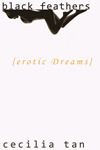 The story is “Penetration,” which first appeared in Best Lesbian Erotica 1997, was later reprinted in “Best of Best Lesbian Erotica,” and also appeared in my collection of erotic short stories that HarperCollins published in 1998, Black Feathers. The story became somewhat infamous at the time, especially since I used to read it aloud to squirming audiences everywhere.
The story is “Penetration,” which first appeared in Best Lesbian Erotica 1997, was later reprinted in “Best of Best Lesbian Erotica,” and also appeared in my collection of erotic short stories that HarperCollins published in 1998, Black Feathers. The story became somewhat infamous at the time, especially since I used to read it aloud to squirming audiences everywhere.
At For Books Sake, Ali Williams wrote an article about “Everyday Objects in Erotica,” ranging from food & drink to detachable shower heads.
Then over at Bon Appetit (yes, the gourmet food mag), Rachel Kramer Bussel wrote about “Food in Erotic Literature.” And picked “Penetration” as one of the “12 Examples to Make your Mouth Water.”
Since it’s been so long since the story was published, and right now you can only get it in the ebook of Black Feathers, I thought maybe I’d re-visit those days when this was a staple of the stories I read at women’s bookstores and sexuality conferences and BDSM events and make an audio recording of it.
So here you go, through the magic of “SoundCloud”, seven minutes of Penetration:
https://soundcloud.com/cecilia-tan-author/penetration-short-story
‘
Not Safe For Work!
February 14, 2014
Happy Valentine’s Day!
People often ask me what I think about Valentine’s Day and I think they expect me to go “ack! p’tui! I hate pink and gooey sentiment and cheap chocolate!”
While all those things are true, though, I love true sentiments, excellent chocolate, and the fact that we HAVE A HOLIDAY SPECIFICALLY ABOUT LOVE. Why wouldn’t I love that? We have how many holidays that are about war? Death? A bunch. We have exactly one holiday which is expressly about love and about appreciating the people you love, and that’s today.
Now, while I think it would be best if people were always so open and free with their emotions that saying “I love you” every single day would be a matter of course, I know not everyone lives in the utopia that I do. Sometimes it’s hard to know what to say or when. There are times when love hurts. But on Valentine’s Day everyone has permission to say it, to express it. Some people need that permission. I don’t begrudge them a holiday that gives it to them.
Yes, I’m the one who told my high school boyfriends that if they ever brought me flowers I was breaking up with them immediately. Why? What I told them, actually, was this: 1) I wasn’t a “girly girl” and if they were going to treat me like one we should not be dating. 2) If they ever felt they had to use flowers as a way to say something, anything, that they felt they couldn’t just TELL ME, then the relationship was already lost. So it wasn’t the flowers themselves I objected to. It was the stupid ways that flowers were often used that I didn’t want to be a party to.
You’ll note I never told them not to get me chocolate, though. I’m not crazy.
February 12, 2014
Alison Tyler talks about THE DELICIOUS TORMENT with me
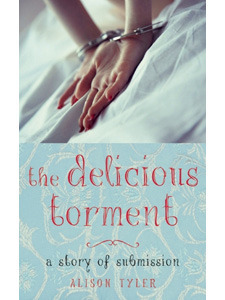 Recently I had the pleasure (and I do mean pleasure) to read the latest in Alison Tyler’s memoir-cum-novels (and I do mean cum), The Delicious Torment: A Story of Submission
Recently I had the pleasure (and I do mean pleasure) to read the latest in Alison Tyler’s memoir-cum-novels (and I do mean cum), The Delicious Torment: A Story of Submission The followup to Dark Secret Love
The followup to Dark Secret Love , The Delicious Torment is aptly named, a terrific and tasty mix of female-submissive BDSM served with literary panache. After devouring the morsels of story that make up the book, I then had the pleasure of interviewing the author.
, The Delicious Torment is aptly named, a terrific and tasty mix of female-submissive BDSM served with literary panache. After devouring the morsels of story that make up the book, I then had the pleasure of interviewing the author.
Cecilia Tan: Would you say that writing itself is a fetish or kink for you?
Alison Tyler: Writing is a necessity to me. Like water or air or chicken wings (with Frank’s hot sauce). If I don’t put words to paper, I get jittery. Editing anthologies fuels my fetish, because I am a total voyeur. I love to see how writers tackle different topics. (This is why I adore hosting my Smut Marathon. There’s one topic—and fifteen, or so, writers who each bring something new to every assignment.)
Cecilia Tan: Do you feel the memoir elements of the book constrain you or free you?
Alison Tyler: Freeing. Like going to a costume party and wearing a glittery mask. There’s that peek-a-boo excitement of playing hide-and-seek with truth and fiction.
Because I dove into this project with no expectations, plans, or even an outline, I’d also say this was the most free-form set of books I’ve ever written. I wrote these books hard. Early in the morning, nearly every day, for a year and a half. I slammed the words against the pages until they begged for mercy. I think if I’d set out to “pen my memoirs” the series would have been stilted. By hiding behind Sam’s façade, I could actually be more me.
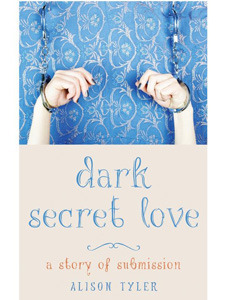 Cecilia Tan: There’s a rabbit hole a writer can go down when writing about D/s. There’s a spectrum from fantasy to reality in most D/s relationships, and then when writing fiction about those relationships it puts another layer on. You put even a third layer on because Dark Secret Love and The Delicious Torment are based on your real-life experiences. Is it important to draw a bright line between fantasy and reality or is the fact that there’s a gray area part of what makes it art? Part of what turns you on? Part of what draws you to it?
Cecilia Tan: There’s a rabbit hole a writer can go down when writing about D/s. There’s a spectrum from fantasy to reality in most D/s relationships, and then when writing fiction about those relationships it puts another layer on. You put even a third layer on because Dark Secret Love and The Delicious Torment are based on your real-life experiences. Is it important to draw a bright line between fantasy and reality or is the fact that there’s a gray area part of what makes it art? Part of what turns you on? Part of what draws you to it?
Alison Tyler: I think that in fiction (even in “fiction” like these books) you should be able to get away with things you might not be able to in real life. So I suppose that could be considered a (shade of) gray. For instance, I wouldn’t recommend not having a safeword if I were writing an article about safe BDSM play—but Sam refuses to use her safeword in book one until the pain connects with Jack and not herself.
Cecilia Tan: Tell me about this sentence: “He held me with his look alone, no words, no threats, so that we were bound together.”
Alison Tyler: Bondage—which is my favorite kink to discuss—comes in so many forms. Of course, there are toys to enhance a BDSM relationship. But I think sometimes simply a gaze can “say” everything.
I’m tempted to publish some of my vintage erotica (currently unavailable) that was written at the time the story was set.
Cecilia Tan: The Delicious Torment has so much in it about the complicated dynamic between Samantha, Jack, and Alex. I often wish for more multi-person relationships in books, for more explorations of polyamory and, for lack of a better word, role models. Do people want you to be an expert on poly for them now? Do your readers ask you for advice?
Alison Tyler: I’m not sure I’m your typical spokes model. I constantly question, debate, disobey. That said, I love discussions. When people do come to me, I often ask if I can open the forum up to other readers and writers for their experiences. More viewpoints can only be a positive.
Cecilia Tan: What would you want written on your tombstone?
Alison Tyler: Ha! You didn’t know this about me, but I’m probably a bit overly fascinated by what people put on their graves. Dorothy Parker wanted Excuse my dust (http://www.dorothyparker.com/dot33.htm). … Mel Blanc’s says: That’s All Folks. Andy Warhol said, “I never understood why when you died, you didn’t just vanish, and everything could just keep going on the way it was only you just wouldn’t be there. I always thought I’d like my own tombstone to be blank. No epitaph and no name. Well, actually, I’d like it to say ‘figment.’”
And check this out… http://www.warhol.org/figment/ — something that sparked a new project I’m working on.
But I’ve actually never thought of what I’d want on mine. Maybe “the end.”
Cecilia Tan: What’s one thing you wish people knew about you or the book that people don’t know or that gets overlooked?
Alison Tyler: Writing is such a solitary activity that making a character into a writer hasn’t appealed to me much in the past. But I reveled in giving Samantha this skill. And I’m tempted to publish some of my vintage erotica (currently unavailable) that was written at the time the story was set. Sort of an “add on” for readers. An extra peek into Samantha’s (and my own) filthy mind.
Cecilia Tan: Anything you’d like to add?
Alison Tyler: Thank you so much for the opportunity. I’m beyond thrilled that you liked the book!
Connect with Alison Tyler:
Blog: http://alisontyler.blogspot.com
Twitter: @alisontyler
February 7, 2014
Pithy Highlights of the Things I Said (while on blog tour for Slow Seduction)
Here’s a compilation of all the essays I wrote on BDSM, romance, etc. and all the interviews I did during my blog tour launching Slow Seduction.
Jan 28: Interviewed by Audra North
“James is trying to teach Karina that it’s very important to love the WHOLE person you’re with, not just their submissive side or their dominant side.”
“The key to the change in Karina is not that through the BDSM ‘training’ she’s learning what her dom likes. It’s that she’s learning what SHE likes.”
Read more at Wonkomance.
Jan 29: Interviewed by Alison Tyler
“I feel like my whole generation of BDSM kinksters has moved into being foodies. In our 20s we were on the forefront of taking/teaching classes and designing new SM toys and combining our geekery with sensual adventuring. Now that we’re in our 40s it’s the same only we’ve replaced kinky sex with gourmet food.”
Read more at Alison Tyler’s Trollop Salon
Jan 30: On Kink-Positive Writing and BDSM, Guest Blog
“Can you imagine if contemporary romances portrayed sex as something the heroine was merely supposed to ‘endure’ for the sake of the hero’s passions? Lie back and think of England? No, books these days tend to portray sex as something the heroine enjoys, and loves, needs, and wants with the hero. Well, BDSM is sex.”
Read more at Exploits of a Chick Lit Aficionado.
Jan 31: Interviewed by Pamela Richardson
“These days I know Robert Pattinson is the thing, but the desperately sensual movie vampire of my teen years was David Bowie in The Hunger.”
“The romance genre has a lot of hero types I would never want to ‘submit’ to in real life: many of them seem like domineering assholes, frankly, and that’s not to even mention subgenres where the hero is an actual rapist. But I also recognize there’s a vast divide between what I think is valuable in a life partner (or play partner) and what works as fantasy fodder for most people.”
Read more at Badass Romance
Feb 1: Reviewed by Jeannie Zelos
“It’s such a treat to get an author who’s clearly put a lot of thought into how to portray sensuality and passion, without just giving us constant, in-your-face, boring-after-a-while sex. … I really enjoyed that Cecilia has taken a different direction with this book. When she does do sex, then it becomes something to be treasured, something special and revered, a magic moment between two lovers, more than just another quick shag, and fits the novel perfectly.”
Read the review at Jeannie Zelos blog
Feb 2: The Power of Fanfiction: The Power of Squee, guest blog
“My job as an erotica writer, I have always felt, is to stir the passions inside the reader. If the reader isn’t holding her breath, clutching her heart, or squeeing with pleasure and glee at what I’ve put on the page, then I’m simply not doing my job.”
“Writing fanfiction sustained me in those dry years [of my career]. It kept my writing chops in shape and it actually honed my ability to induce squee.”
Read more at The FanVault blog
Feb 3: Why Writing About Female Submission is a Feminist Act, guest blog
“As Karina learns, dominance and submission doesn’t mean James dictates her every move. It means they have a framework within which each partner has agency. Unlike ‘traditional’ relationship structures, which hand the majority of the power and privilege to the male partner, in a BDSM relationship the power is split in a systematic way.”
Read more at the I.G. Frederick EroticaWriter blog
Feb 4: Sex City Radio podcast
Feb 4: Blog Post: Pre-Raphelite Art in Slow Seduction
Sometimes things I invent for the sake of plot of convenience in my books… turn out to be real. Blog post with lots of photos of the Pre-Raphaelite paintings and galleries where scenes take place in Slow Seduction. Read more & see photos: http://blog.ceciliatan.com/?p=1683
Feb 5: BDSM Romance: It’s Everywhere Now, guest blog
“BDSM is a bit like Mexican food. To some it seems strange and exotic. Why would you put hot peppers into food? Don’t they hurt?”
Read more at Tilly Greene’s Hot Thoughts
Feb 6: Interviewed by Kerry Adrienne
“All I saw was Karina pulling the marble out of James’s pocket and putting it in her mouth, the big moment in the scene where they meet in the bar.”
“I knew I was trying to write a BDSM book: most people minds would have gone straight to the dungeon or to handcuffs or a spanking. My mind went somewhere else completely.”
Kerry Adrienne’s Escape Velocity blog
I’ll be taping an appearance on Susie Bright’s podcast “In Bed With Susie Bright” later this month, as well.
And then there is the two-part video chat I did on uStream, now on Youtube:
February 4, 2014
More erotic romance covers: flowers, more ribbons
 So my search continues to try to find an erotic BDSM romance that used a pearl necklace on the cover before Slow Surrender, but it’s looking more and more like the designer at Hachette might have been a very early adopter of female accoutrements/jewelry to “the look.” (See my previous picspam post of trends in erotic romance covers ever since 50 Shades of Grey. Who knew that book title was going to literally describe the monotone and desaturated look that would come to dominate? Heh heh, I said “dominate.”)
So my search continues to try to find an erotic BDSM romance that used a pearl necklace on the cover before Slow Surrender, but it’s looking more and more like the designer at Hachette might have been a very early adopter of female accoutrements/jewelry to “the look.” (See my previous picspam post of trends in erotic romance covers ever since 50 Shades of Grey. Who knew that book title was going to literally describe the monotone and desaturated look that would come to dominate? Heh heh, I said “dominate.”)
I mentioned in the previous post there were SO MANY books with a red ribbon. That’s expanded to blue and purple now, too:
And I mentioned lots of covers have flowers on them as the single object of focus. Here’s a compilation of recent flower covers:
One point I feel I should make. I am not in any way complaining that these books look so similar. I think it’s rather brilliant, actually, that without any actual discussion taking place from one publisher’s art department to another, a consensus has emerged around what this genre “looks like.” Of course, now it perhaps is getting overdone, which is why it is evolving in various directions, yet still maintaining various signifiers. In the previous post I talked about the leap into jewelry and below I’ll get into some other trends that are appearing.
Someone did point me at one indie/self-pub book entitled Surrender that has both the commonly seen high-heeled shoe and a pearl necklace! But the pub date is March 29, 2013, two full months after Slow Surrender had its release, and I also note that it had two versions of the cover, one that was more in the style of the dark-with-one-color vein and one that was more “contemporary” romance looking.
And for fun here are two MORE covers with high heels on them:
One author whose covers consistently have been going AGAINST the trend, I think very intelligently so, is Maya Banks. Her publisher went the opposite way for her “Breathless” trilogy, using WHITE instead of black/gray/desaturated-blue:
And now they’re going all out with super-saturated colors for her latest series, but I note the series is called what? The “Surrender” trilogy. And the images are what? Flowers. So they’re staying firmly within the genre conventions and milieu, and yet giving them a really vibrant look:
I haven’t read these yet, myself, but my impression from reading reviews is that the insides are as vibrant as the covers! Fitting.
Writing the Pre-Raphaelites in Slow Seduction
They say sometimes fiction becomes real. I’ve had the experience numerous times that something I cooked up in my imagination turned out to be real.
For example, in the BDSM novella I wrote for Entwined, Dear Girl, our heroine is intrigued by the small leather book she sees a man holding in his hands. Is it a small Bible? An address book? She later discovers it’s a cell phone case made to look like a tiny leatherbound book. About a year after I had written that story I was browsing Amazon.com and what did I find? Smartphone cases that look like small leather books! (Yes, I bought one immediately.)
The most recent example, though, of my power to make stuff up only to have it happen was during the writing of Slow Seduction. When the book opens, Karina has gone to London for the summer. A curator at the Tate Britain has brought her there to lead tours of a special exhibition of art never-before-gathered-in-one-place. In book one of the series, we learn Karina wrote her thesis on Pre-Raphaelite art. This exhibit is to be the first time so many pre-Raphaelites were ever exhibited together.
I totally made that up.
Except then I went on a trip to the U.K. (for the IASPR scholarly romance conference in York, England), which was going to give me one “tourist” day in London. And when I looked around to see what there was to see, I wondered if maybe a few of the pre-Raph paintings I talked about in the book might be on display.
 And I discovered that a huge exhibition of never-before-gathered-in-one-place Pre-Raphaelite art was going to be opening at the Tate Britain shortly before I would arrive.
And I discovered that a huge exhibition of never-before-gathered-in-one-place Pre-Raphaelite art was going to be opening at the Tate Britain shortly before I would arrive.
I even had the museum right.
So, of course I had to go see the exhibit! Which was marvelous. The Burne-Jones paintings I had picked out as Karina’s favorites while writing Slow Surrender were the finale at the end of the show! I spent several hours there, until hunger and thirst drove me in search of afternoon tea.
In the course of writing Slow Seduction, I was able to set many scenes in the gallery and in the museum.
What follows are photos of the gallery and museum with some of my descriptions on where they fit in the book. It will not be spoilery if you have not yet read the book, but if you have read it, here’s what the art I couldn’t show in the book looked like!

The day I arrived it was raining and I was there when the doors opened. Here's the entrance.
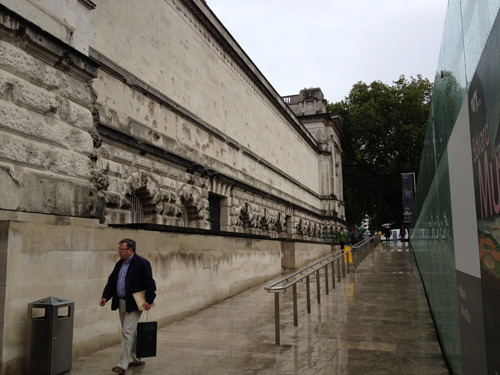
The rain made everything slick. I wasn't sure if this is always the entrance or only during the massive renovations going on.

The actual door. Perhaps that sign says something now?
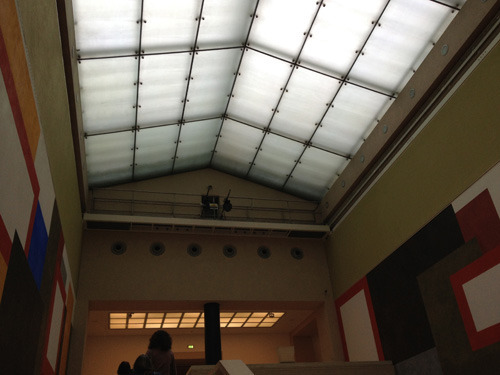
From the ticket-buying area one goes up a wide set of stairs under a skylight.

View from the top of the stairs looking down. Very modernist, though this was at Tate Britian, not Tate Modern, which is a different museum.

At the top of the stairs, I went through another set of doors...

Across another gallery...

And then caught sight of the banner of Rossetti's Astarte! With arrow pointing "this way"...
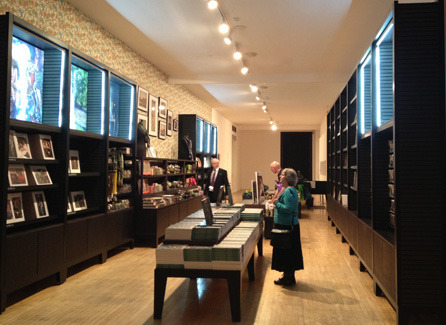
Putting you directly into the Pre-Raphaelite Gift Shop. (Which was also the entrance to the exhibit. I didn't photograph the velvet-rope queue.)
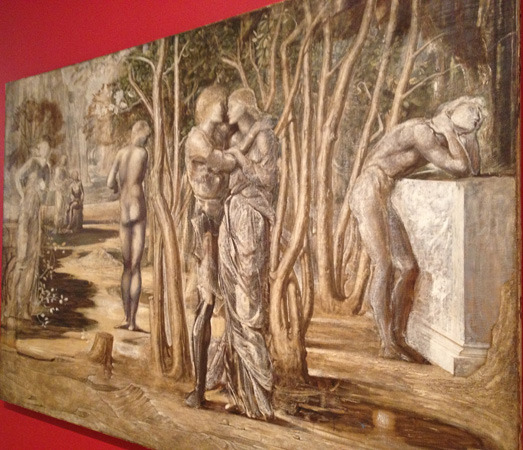
Oddly, the thing you look at while in the queue to enter the exhibit is what? An unfinished painting by Edward Burne-Jones, newly discovered?? And it has a love-triangle/love unrequited theme? Perfect!!

The exhibit was in a series of linked rooms, like many exhibits of this type. Here's one of them.

The "brotherhood" included women like Christina Rossetti. A book of her Goblin Market, illustrated by Dante Rossetti.

And a book illustrated by Burne-Jones. I wondered why there seemed to be so very little of his stuff as I went through the rooms...
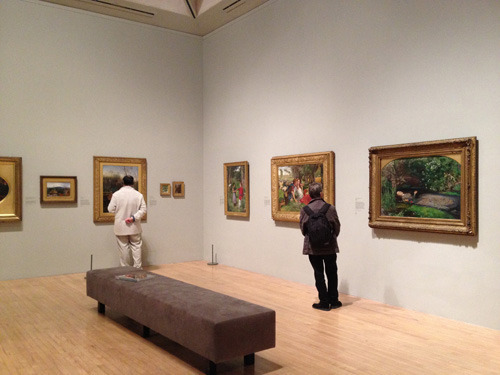
Here's another one of the galleries. The really mind-blowing stuff was all in the last room, though.

All the Burne-Jones paintings but a few were in the "wow" room, the final room in the exhibit. Here's Perseus and Andromeda, the only nude in the exhibit.

Burne-Jones's paintings overall were much more emotional and concerned nearly always with lovers, like this one. (Which made the stark portrait of his wife, not pictured here, an interesting psychological study...)

And finally to Karina's favorite painting, and mine, King Cophetua and the Beggar Maid, an ancient Cinderella-like story. This painting is huge, ten feet tall? Or more?

Detail showing the amazing textures in the gold stairwell in the painting.
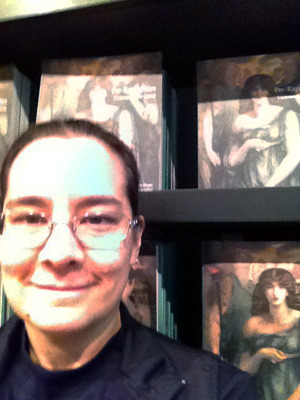
And that was about it! Here's a selfie of me in the gift shop, where the light was way too bright!

